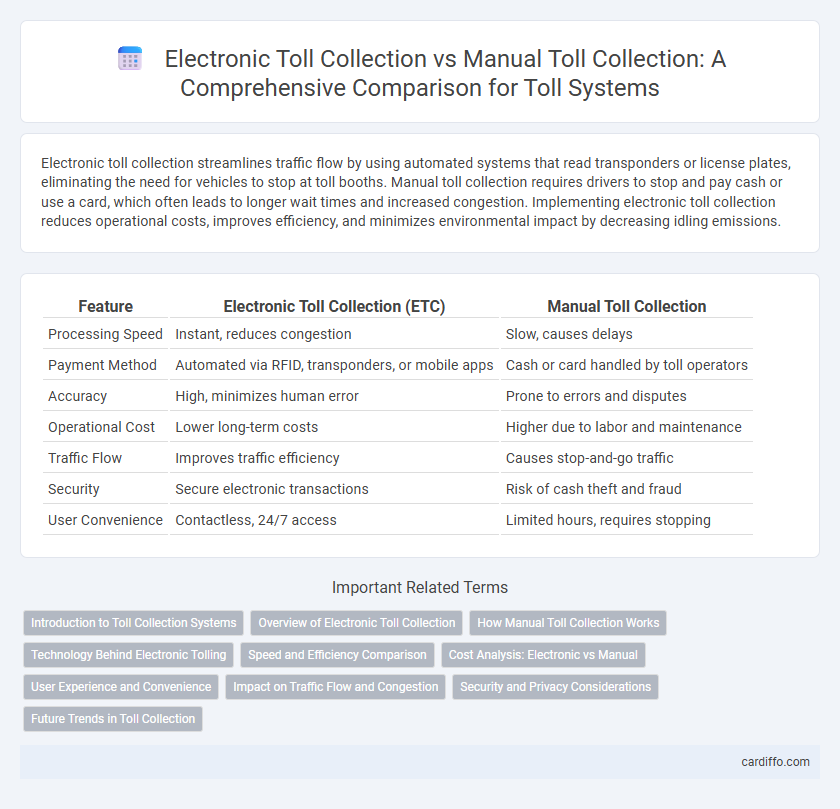Electronic toll collection streamlines traffic flow by using automated systems that read transponders or license plates, eliminating the need for vehicles to stop at toll booths. Manual toll collection requires drivers to stop and pay cash or use a card, which often leads to longer wait times and increased congestion. Implementing electronic toll collection reduces operational costs, improves efficiency, and minimizes environmental impact by decreasing idling emissions.
Table of Comparison
| Feature | Electronic Toll Collection (ETC) | Manual Toll Collection |
|---|---|---|
| Processing Speed | Instant, reduces congestion | Slow, causes delays |
| Payment Method | Automated via RFID, transponders, or mobile apps | Cash or card handled by toll operators |
| Accuracy | High, minimizes human error | Prone to errors and disputes |
| Operational Cost | Lower long-term costs | Higher due to labor and maintenance |
| Traffic Flow | Improves traffic efficiency | Causes stop-and-go traffic |
| Security | Secure electronic transactions | Risk of cash theft and fraud |
| User Convenience | Contactless, 24/7 access | Limited hours, requires stopping |
Introduction to Toll Collection Systems
Electronic Toll Collection (ETC) systems leverage RFID technology and automated payment processing to enable seamless vehicle passage without stopping, significantly reducing traffic congestion and improving toll plaza efficiency. Manual Toll Collection relies on human toll operators to collect cash or card payments, leading to increased wait times and higher operational costs. Advanced ETC solutions, such as transponders and license plate recognition, optimize toll revenue management and enhance user convenience on highways and bridges.
Overview of Electronic Toll Collection
Electronic Toll Collection (ETC) systems utilize radio-frequency identification (RFID) or dedicated short-range communication (DSRC) technology to automatically deduct toll fees without requiring vehicles to stop, significantly reducing traffic congestion and improving travel time. These systems integrate with vehicle-mounted transponders and centralized databases to ensure accurate billing and real-time data management. Widespread adoption of ETC enhances operational efficiency, lowers labor costs, and supports dynamic pricing models based on traffic flow and time of day.
How Manual Toll Collection Works
Manual toll collection involves toll booth operators who accept cash or card payments from drivers, record transactions, and provide change if necessary. This system requires physical infrastructure such as toll plazas and staffed lanes, leading to slower traffic flow compared to electronic methods. Despite higher labor costs and potential delays, manual collection remains essential in regions lacking electronic toll infrastructure.
Technology Behind Electronic Tolling
Electronic Toll Collection (ETC) systems leverage advanced technologies such as RFID (Radio Frequency Identification), DSRC (Dedicated Short-Range Communications), and ANPR (Automatic Number Plate Recognition) to enable seamless, automated toll payments without stopping vehicles. These technologies communicate with transponders or use cameras to identify vehicles, facilitating real-time toll deduction and reducing traffic congestion. Integration with centralized databases and mobile payment platforms enhances accuracy, security, and user convenience compared to traditional manual toll collection methods.
Speed and Efficiency Comparison
Electronic Toll Collection (ETC) significantly outperforms manual toll collection in speed and efficiency, allowing vehicles to pass through toll points without stopping, thereby reducing congestion and wait times. ETC systems use RFID or automatic number plate recognition technology to process payments instantly, enhancing traffic flow and minimizing operational costs. Manual toll collection requires vehicle stoppage for cash or card payments, causing delays, increased fuel consumption, and higher labor expenses.
Cost Analysis: Electronic vs Manual
Electronic toll collection significantly reduces operational costs by minimizing labor expenses and increasing transaction speed compared to manual toll collection, which requires continuous staffing and slower processing times. Investment in electronic infrastructure involves upfront capital but results in lower long-term maintenance and operational costs. Cost analysis reveals that electronic systems provide higher efficiency and scalability, leading to overall savings for toll operators and reduced congestion for drivers.
User Experience and Convenience
Electronic Toll Collection (ETC) significantly enhances user experience by enabling seamless, contactless vehicle passage, reducing wait times and eliminating the need for cash handling. Manual toll collection, in contrast, often results in longer queues and increased transaction times due to cash exchanges and manual validation. The convenience of ETC systems, supported by RFID or transponder technology, streamlines toll payment, offering drivers a faster and more efficient journey on toll roads.
Impact on Traffic Flow and Congestion
Electronic Toll Collection (ETC) significantly improves traffic flow by allowing vehicles to pass through toll points without stopping, reducing congestion and delays commonly seen with manual toll collection. Manual toll booths cause frequent bottlenecks as vehicles queue for cash payments, increasing travel time and emissions. Studies show ETC can reduce toll plaza waiting times by up to 80%, enhancing overall road efficiency and minimizing traffic buildup during peak hours.
Security and Privacy Considerations
Electronic Toll Collection (ETC) systems enhance security by employing encrypted data transmission and automated vehicle identification methods, reducing risks of toll evasion and fraud compared to manual collection. Manual toll collection exposes vulnerabilities such as human error, cash mishandling, and unauthorized access to collected funds, increasing privacy concerns related to physical interactions and record keeping. ETC's use of anonymized vehicle tags and secure databases provides improved privacy controls, though challenges remain regarding data retention policies and unauthorized tracking.
Future Trends in Toll Collection
Electronic Toll Collection (ETC) systems are rapidly advancing with technologies such as RFID, ANPR (Automatic Number Plate Recognition), and mobile payment integrations, enabling seamless and contactless toll transactions. Future trends indicate a shift towards fully automated tolling infrastructures powered by AI and IoT, reducing congestion and operational costs while enhancing real-time traffic management. Manual toll collection is expected to phase out gradually due to inefficiencies, higher labor costs, and the rise of smart cities prioritizing digital infrastructure.
Electronic Toll Collection vs Manual Toll Collection Infographic

 cardiffo.com
cardiffo.com